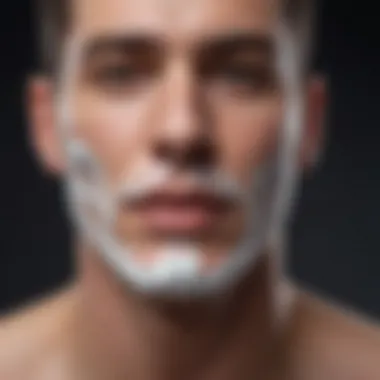Expert Tips for Preventing Razor Burn on Your Neck with Ease


Trendy Haircut Trends
Have you ever struggled with razor burn on your neck after shaving? Let's delve into effective techniques to prevent this common issue and ensure your skin stays smooth and irritation-free. The neck region is sensitive and prone to razor burn, making it crucial to adopt the right preventive measures. From proper preparation to post-shaving care, this guide will equip you with essential steps to take for a comfortable shaving experience.
To begin, it's essential to prepare your skin before shaving. Remember, proper hydration and exfoliation play a significant role in preventing razor burn. Ensure your skin is well-moisturized to soften the hair and provide a protective barrier during shaving. Exfoliation helps remove dead skin cells, reducing the chances of ingrown hairs that can lead to irritation and razor burn.
Next, let's focus on the shaving technique itself. Always use a sharp razor to minimize repeated strokes on the skin, which can trigger irritation. Shave in the direction of hair growth to reduce friction and avoid pulling on the hair follicles. Rinse the blade regularly to maintain its effectiveness and prevent clogging, which can increase the risk of razor burn. Additionally, consider using a shaving cream or gel to lubricate the skin and improve the gliding of the razor.
After shaving, proper aftercare is crucial to prevent razor burn on the neck. Remember to rinse your skin with cool water to soothe any potential irritation and close the pores. Pat your skin dry gently with a clean towel, avoiding harsh rubbing that can further aggravate the skin. Apply a gentle moisturizer or aftershave to hydrate the skin and reduce redness. Look for products that are specifically designed for sensitive skin to minimize the risk of irritation.
Understanding the Razor Burn on the Neck
In today’s grooming landscape, the issue of razor burn on the neck stands as a formidable challenge, especially for men who prioritize a well-manicured appearance. The significance of comprehending razor burn lies in its ability to mar the smooth finish one aims to achieve post-shave. This article delves deep into the intricacies surrounding this common nuisance, shedding light on the causes, symptoms, and preventive measures essential for a seamless shaving experience.
Causes of Razor Burn
Improper Shaving Technique
Exploring the facet of improper shaving technique unveils a crucial aspect influencing the occurrence of razor burn. The improper angle or pressure during shaving can result in skin irritation and redness, disrupting the desired silhouette. This article emphasizes the repercussions of hasty or negligent shaving methods and advocates for precision in each stroke to mitigate these consequences.
Sensitive Skin
The vulnerability of sensitive skin amplifies the susceptibility to razor burn, intensifying the aftermath of a shave. Sensitivities vary among individuals, necessitating tailored precautionary measures to safeguard the skin from adverse reactions. Recognizing the unique demands of sensitive skin equips one with the foresight to adopt gentler practices to ensure a comfortable and blemish-free grooming routine.
Dull Blades
The diminished efficacy of dull blades poses a prevalent risk factor for aggravating razor burn. Blades that lack sharpness tend to tug at the hair follicles, provoking skin inflammation and discomfort. This section underscores the imperative need for routine blade replacement to uphold a pristine shaving experience, steering clear of the pitfalls associated with blunted tools.
Symptoms of Razor Burn
Redness
Redness surfaces as a prominent indicator of razor burn, signaling skin inflammation post-shave. The discernible hue shift serves as a visual cue for the extent of skin irritation, prompting immediate remedial action. Understanding the nuances of redness aids in discerning the severity of razor burn, facilitating targeted interventions for a rapid recovery and restoration of skin equilibrium.
Irritation
Irritation manifests as a palpable discomfort following a shaving session, manifested through a tingling or burning sensation. This segment elucidates the underlying triggers of skin irritation, advocating preventive measures to preemptively address the root cause. By dissecting the complexities of irritation, individuals can tailor their grooming practices to avert its recurrence, fostering a harmonious relationship between grooming and skin well-being.


Bumps
Bumps materialize as a sporadic aftermath of shaving, contributing to the unsightliness of razor burn. These protuberances, whether pimple-like or inflamed, underscore the skin's reactive state post-shave. Insight into the genesis of bumps empowers individuals to adopt practices that minimize their occurrence, elevating the post-shave experience to one characterized by smoothness and suppleness.
Pre-Shave Preparation
Pre-shave preparation is a crucial aspect of achieving a smooth and irritation-free shaving experience, especially when targeting the sensitive skin on the neck. It sets the foundation for a comfortable shave by focusing on two key elements: Warm Water Exposure and Exfoliation. Prior to shaving, one must pay diligent attention to preparing the skin to minimize the risk of razor burn and ingrown hairs, which are common issues faced by many individuals. Implementing a thorough pre-shave routine not only enhances the efficacy of the shave but also promotes skin health in the long run.
Warm Water Exposure
Opening pores
One of the primary objectives of warm water exposure during pre-shave preparation is to facilitate the dilation of pores on the skin. By exposing the skin to warm water, the pores expand, making it easier for hairs to be removed effectively. This process aids in preventing ingrown hairs and achieving a closer shave. The warmth from the water relaxes the facial muscles, creating a more comfortable shaving experience. However, it is essential to regulate the water temperature to avoid excessive heat that could potentially cause skin irritation.
Softening hair
Softening the hair shaft is another pivotal benefit of warm water exposure in the pre-shave routine. When the hair becomes softer, it becomes more pliable and easier to cut without tugging at the skin. This helps reduce the likelihood of razor burn and skin irritation post-shaving. Additionally, softened hair results in a smoother shave, as the razor glides more effortlessly across the skin surface, enhancing precision and comfort. While warm water exposure is advantageous for hair softening, it is crucial to exercise caution not to oversaturate the skin, as overly soft hair may lead to challenges in shaving smoothly.
Exfoliation
Removing dead skin cells
Exfoliation plays a vital role in pre-shave preparation by eliminating dead skin cells from the skin's surface. Dead skin cells can clog pores, leading to ingrown hairs and razor burn. By incorporating exfoliation into the routine, smooth skin is revealed, promoting a closer and more effective shave. Furthermore, exfoliation aids in preventing skin irritation and inflammation post-shaving, contributing to an overall smoother complexion. It is imperative to choose a gentle exfoliant that suits your skin type to avoid excessive scrubbing that could potentially damage the skin barrier.
Preventing ingrown hairs
Preventing ingrown hairs is another key benefit of exfoliation in the pre-shave regimen. By sloughing away dead skin cells and unclogging pores, exfoliation reduces the chances of hair follicles becoming trapped beneath the skin's surface. This, in turn, minimizes the occurrence of ingrown hairs, promoting healthier and clearer skin. Regular exfoliation not only supports a more comfortable shave but also enhances the skin's overall texture and appearance. It is essential to integrate exfoliation into the pre-shave routine to maintain optimal skin health and combat common shaving challenges.
During Shaving
During shaving plays a crucial role in the overall process of preventing razor burn on the neck. It is a stage where specific elements like proper technique and lubrication come into play to ensure a smooth and irritation-free shaving experience. Proper shaving technique, involving the use of sharp blades, maintaining light pressure, and following the hair growth direction, is essential for achieving a clean shave without causing irritation or razor burn.
Proper Shaving Technique
Proper shaving technique is the cornerstone of a successful shave without razor burn, and it encompasses several key aspects that contribute to a comfortable and effective shaving experience.
Use of sharp blades
The use of sharp blades is paramount when aiming for a close shave without causing irritation or razor burn. Sharp blades cut through the hair smoothly, reducing the need for multiple passes over the same area. This not only minimizes skin irritation but also lowers the chances of ingrown hairs, a common issue associated with dull blades.


Light pressure
Applying light pressure while shaving is essential to prevent razor burn. Exerting too much pressure can cause the blades to scrape against the skin, leading to irritation and redness. By maintaining light and gentle strokes, individuals can achieve a close shave while minimizing the risk of skin damage.
Following hair growth direction
One of the key aspects of proper shaving technique is following the direction of hair growth. Shaving against the grain can increase the likelihood of razor burn and ingrown hairs. By shaving in the direction of hair growth, individuals can reduce friction on the skin, resulting in a smoother shave with less irritation.
Lubrication
Lubrication plays a vital role in ensuring a comfortable and effective shaving experience, helping to reduce friction between the razor and the skin while providing hydration and protection.
Quality shaving cream
Using a high-quality shaving cream is essential for creating a smooth shaving surface and minimizing skin irritation. Quality shaving creams help to soften the hair, allowing the razor to glide effortlessly while providing a protective barrier between the blade and the skin. Opting for a cream that suits your skin type can make a significant difference in preventing razor burn.
Avoiding alcohol-based products
Avoiding alcohol-based products is crucial for individuals prone to razor burn. Alcohol can strip the skin of its natural oils, drying it out and making it more susceptible to irritation. By opting for alcohol-free shaving products, individuals can maintain skin hydration and reduce the risk of redness and discomfort post-shave.
Post-Shave Care
Post-shave care is a crucial aspect in the pursuit of a smooth and irritation-free neck after shaving. This segment of the grooming routine plays a vital role in ensuring the skin's health and appearance. By following the right post-shave care practices, individuals can prevent razor burn, redness, and bumps, leading to a comfortable and satisfying shaving experience. Effective post-shave care involves specific steps and products that aid in soothing the skin and promoting recovery.
Rinse with Cold Water
Closing pores
Closing pores post-shaving is a strategic step that aids in maintaining skin health and appearance. This process involves using cold water to tighten the skin's pores, reducing the likelihood of dirt and bacteria entering and causing irritation. The act of closing pores also helps in promoting skin resilience and restoration. By emphasizing the closing of pores in the post-shave routine, individuals contribute to overall skin health and appearance, ensuring a refreshing and rejuvenating experience.
Reducing inflammation
Reducing inflammation after shaving is essential for preventing redness and discomfort. This step involves the application of cold water or soothing products to calm the skin and minimize any post-shave irritation. By focusing on reducing inflammation, individuals can promote faster skin recovery and alleviate the uncomfortable effects of shaving. Implementing effective inflammation-reducing techniques enhances the overall post-shave experience, resulting in smoother and healthier skin.
Moisturization
Moisturization plays a significant role in post-shave care, especially in hydrating the skin and restoring its natural balance. This process involves the application of moisturizers that nourish the skin and help in maintaining its suppleness and elasticity. By prioritizing skin hydration, individuals can prevent dryness, flakiness, and irritation, resulting in a more comfortable post-shave sensation.
Hydrating skin


Hydrating the skin post-shaving is essential for replenishing lost moisture and promoting skin health. This aspect focuses on using hydrating products or natural remedies to restore the skin's water content and enhance its overall texture. By prioritizing skin hydration, individuals can support the skin's barrier function and reduce the risk of post-shave dryness.
Soothing irritation
Soothing post-shave irritation is key to minimizing discomfort and redness. This component involves the application of calming ingredients or treatments that help in reducing skin sensitivity and inflammation. By soothing irritation effectively, individuals can experience relief from post-shave discomfort and promote faster skin recovery, leading to a more enjoyable shaving experience.
Additional Tips
To ensure a smooth and irritation-free shaving experience, incorporating additional tips into your routine can make a significant difference. These tips go beyond the basic steps of pre-shave preparation and post-shave care, offering an extra layer of protection for your skin. By following these suggestions conscientiously, you can reduce the chances of experiencing razor burn on your neck. : However, be wary of : choosing skincare products containing harsh components like alcohol-based aftershaves and fragranced products, as they can exacerbate skin irritation instead of soothing it.
Avoiding Harsh Products
When it comes to skincare products, it is crucial to steer clear of harsh ingredients that can trigger razor burn and discomfort. In the realm of aftershaves, alcohol-based formulas are commonly used for their antiseptic properties. : However, they can also strip the skin of its natural oils, leading to dryness and irritation. On the other hand, fragranced products may contain artificial scents that can be irritating to sensitive skin. The added fragrance can : sometimes cause allergic reactions or exacerbate existing skin conditions, making them unsuitable for individuals prone to razor burn. By avoiding such harsh products and : opting for gentle, fragrance-free alternatives, you can safeguard your skin against unnecessary inflammation and redness.
Alcohol-based aftershaves
Alcohol-based aftershaves are renowned for their astringent properties. While they can effectively tighten the pores and : disinfect the skin post-shave, they tend to : create a stinging sensation, particularly on sensitive or freshly shaved skin. This stinging : sensation indicates that the alcohol is causing micro-damage to your skin barrier, potentially exacerbating the likelihood of razor burn. Despite their : antiseptic benefits, alcohol-based aftershaves may not be the best choice for individuals seeking optimal skin health and comfort after shaving.
Fragranced products
: Fragranced products are popular in the realm of shaving due to : the pleasant scents they offer. However, these fragrances are often synthetic, containing : chemicals that can be harsh on the skin. If you have sensitive skin or are prone to razor burn, using fragranced creams, : lotions, or aftershaves may lead to skin irritation or allergic reactions. Opting for unscented products can : help reduce the risk of adverse reactions and maintain the health of your skin post-shave.
Regular Razor Maintenance
Maintaining your razor in optimal condition is paramount for preventing razor burn on your neck. Blades that are dull or : filled with debris can tug at hairs instead of cleanly cutting them, leading to irritation and : ingrown hairs. By changing your blades : regularly, you ensure a sharp and clean shave, reducing the risk of razor burn and : other skin issues. Additionally, cleaning your razor after every use helps to : prevent bacterial buildup, : which can cause infections and exacerbate skin irritation. By practicing regular razor maintenance, you : prioritize the health and comfort of your skin, enhancing your shaving experience overall.
Changing blades regularly
Regularly changing your razor blades is essential for maintaining a smooth and efficient shave. Dull blades can pull at the skin : rather than smoothly cutting through the hair. This can lead to redness, irritation, and even razor burn. By : replacing your blades regularly, typically after a few uses or signs of dullness, you ensure a consistently comfortable and effective shaving experience.
Cleaning razor after use
After each shave, it is crucial to clean your razor thoroughly to : remove any leftover shaving cream, hair, or debris. Residue left on the razor can harbor bacteria, increasing the risk of skin infections or : irritations. By rinsing your razor with hot water and : occasionally disinfecting it with alcohol, you maintain a hygienic shaving tool that promotes skin health and reduces the chances of developing razor burn.
Professional Help
In some cases, seeking professional guidance can be beneficial for managing razor burn and : related skin issues effectively. Dermatologists specialize in skin health and can provide tailored recommendations to : address your specific concerns. By consulting a dermatologist, you gain access to expert knowledge and : personalized care, ensuring that your skin receives the attention it needs to : stay healthy and irritation-free post-shave.
Consulting a dermatologist
A dermatologist can offer valuable insights into your skin type, sensitivity, and : potential triggers for razor burn. : By understanding your skin's unique needs, a dermatologist can recommend suitable : products and techniques to prevent irritation and maintain skin health. Dermatological advice can : be particularly beneficial for individuals with persistent razor burn or those with underlying skin conditions that require : specialized attention.
Seeking specialized advice
For individuals with specific skin concerns or : stubborn razor burn, seeking out specialized advice from skincare professionals can : provide targeted solutions. These experts can : offer custom-tailored recommendations and treatments to alleviate razor burn and prevent future : occurrences. By investing in specialized advice, you prioritize the long-term health and comfort of your skin, ensuring a smooth and irritation-free shaving experience.















